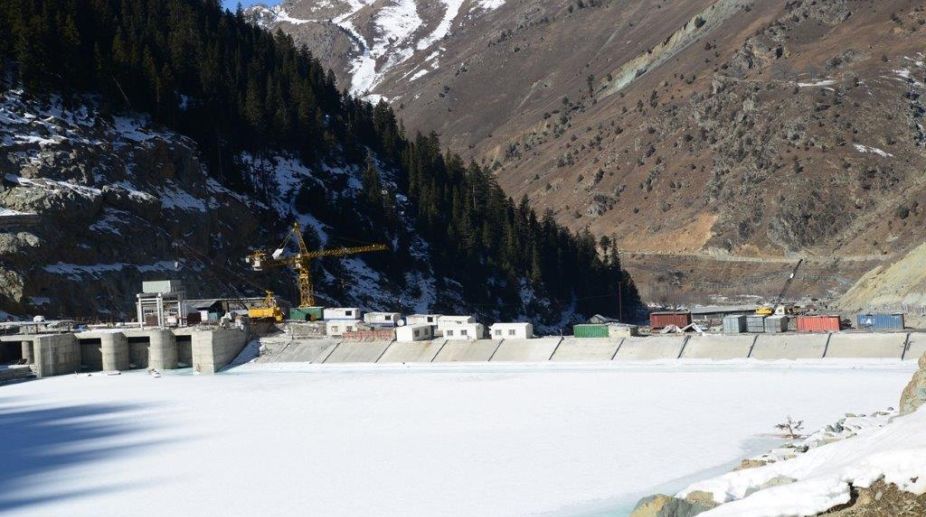Biotech potential of J&K needs to be explored: Dr. Jitendra Singh
He underscored the rise in DBT’s Budget from 1,485 crores in 2013-14 to 3,447 crores in 2025-26 almost marking 130% increase.
In 2010, Pakistan moved The Hague court claiming the project was in violation of the Indus Water Treaty, that regulates use of waters of the shared rivers.

Kishanganga Hydroelectric Project (Photo: http://www.nhpcindia.com)
With Prime Minister Narendra Modi is set to inaugurate North Kashmir’s 330 mega watt Kishanganga hydroelectric project on Saturday, its is not only a long-cherished dream of the region but also a major geopolitical win at the highest level of international court for India.
The project, an engineering marvel constructed near the Line of Control (LoC) in Gurez by NHPC, had been opposed by Pakistan that had moved the International Court of Arbitration in The Hague against it in 2010.
Advertisement
Pakistan had accused India of violating the Indus Waters Treaty (IWT) that regulates use of waters of the shared rivers and by constructing the project, India has in a way asserted its rights on the river’s water under the treaty.
Advertisement
In 2013, it was a major victory for India when The Hague allowed India to go ahead with construction of the project just near the Line of Control (LoC) between India and Pakistan-occupied Kashmir (PoK) in the Bandipora district of the Valley.
The international court asked India to let 9 cubic metres of water flow into the Neelum (Kishanganga has been named as Neelum in the PoK).
Pakistan has complained that the Kishanganga Project affects its own Neelum Jheelum Hydropower Plant. The Kishanganga is called the Jheelum on the other side of the LoC.
Pakistan had approached the World Bank in 2016, raising concerns over the designs of two hydroelectricity projects located in Jammu and Kashmir.
It had demanded that the World Bank, which is the mediator between the two countries under the 57-year-old water distribution pact, set up a court of arbitration to look into its concerns.
The international lender had in November 2016 initiated two simultaneous processes for appointing neutral expert and establishing of a court of arbitration to look into technical differences between the two countries in connection with the projects.
The simultaneous processes, however, were halted after India objected to it. In 2017, The World Bank in its face sheet, while noting that the two countries disagree over whether the technical design features of the two hydroelectric plants contravene the treaty, had said that the IWT designates these two rivers as well as the Indus as the “Western Rivers” to which Pakistan has unrestricted use.
“Among other uses, India is permitted to construct hydroelectric power facilities on these rivers subject to constraints specified in annexures to the treaty,” the Bank said in its fact sheet.
It noted that the talks on the technical issues of the IWT took place this week “in a spirit of goodwill and cooperation”.
The IWT was signed in 1960 after nine years of negotiations between India and Pakistan with the help of the World Bank, which is also a signatory.
The talks between the two nations over the treaty came amid tensions between them after a number of terror attacks in India by Pakistan-based terror groups.
On Friday, Pakistan expressed “serious concerns” over the inauguration of the project, once again terming it a “violation of the Indus Waters Treaty”.
A statement issued by its Foreign Office said, “Pakistan believes that the inauguration of the project without the resolution of the dispute is tantamount to violation of the Indus Waters Treaty (IWT).”
The Pakistan Foreign Office also said the World Bank, which is the custodian of the treaty, must urge India to address Pakistan’s reservations on the Kishanganga project.
However, India has always maintained that the project would not have any impact on the rivers flowing into the neighbouring country.
Here is all you need to know about the Kishanganga project:
The 330 MW project, located in the Gurez valley of Bandipora district, was started in 2007. Constructed at a cost of Rs 5,750 crore, the Kishanganga project is expected to generate 1713 million units of electricity per annum.
The project features three power generating units of 110 MW each, all of which were successfully commissioned. NHPC, Hydroelectric power generation company, responsible for the construction and development has said that all three units have been synchronised with the grid and the project achieved full generation of its rated 330 MW capacity.

The hydel dam is located in the Gurez Valley of Bandipora district, north of Srinagar. It also lies to the north of Wular Lake, the site of another Indian project that Pakistan has attempted to stop.
The Kishanganga Hydroelectric Project is a run-of-the-river project that includes a 37-meter high concrete rock fill dam across the Kishanganga River, located just before it flows across the Line of Control (LoC) into Pakistan-occupied Kashmir (PoK). It diverts the water to an underground power house through a 23.25 km tunnel.
The project will generate 1,713 million units per annum, the National Hydroelectric Power Corporation (NHPC) has said. The state of Jammu and Kashmir would be provided with 12 percent of the power generated by the project.

In 2010, Pakistan moved The Hague court claiming the project was in violation of the Indus Water Treaty, that regulates use of waters of the shared rivers.
It was a great victory for India in 2013 when the court allowed India to go ahead with construction of the project just near the Line of Control (LoC) between India and Pakistan-occupied Kashmir (PoK) in the Bandipora district of the Valley.
Advertisement